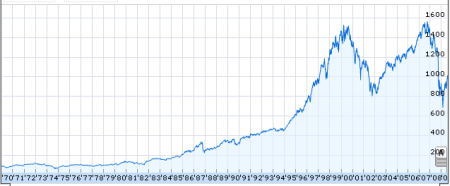Why You Don’t Want To Invest Your Money All At Once
In today’s post you will learn why you don’t want to invest all of you money at once possibly costing you thousands of dollars.
What Happens When You Invest All Of Your Money At Once
When you invest all of your money at once you could be buying shares at a low price, or you could be paying way too much for them. How do you know? You don’t, unless you’re a genius.
The point is that investing all your money at one time can be either really smart or incredibly dumb. For instance if you would’ve invested $10,000 in the S&P 500 in late 1999 you would have overpaid for those shares. Look at the chart below.
However if you would have invested that same $10,000 in 2002 you would bought at a much lower price, and would have been on track to make some significant gains over the next 5 years. On the flip side if you would have invested it all in 1999 you would’ve spent the next three years losing nearly 50% of everything you invested.
The problem is you don’t know when the market is going to bottom out and you don’t know when the market is going to reach its high. So how can you protect yourself from falling victim to this financial mistake?
The answer is dollar cost averaging also known as DCA. Dollar cost averaging is a simple approach to investing the same amount of money at the same time over a long period of time.
How Dollar Cost Averaging Works
In this example you can see what would happen if you would just invest one lump sum payment.
Date Amount Cost Per Share Shares Purchased
Jan. $12,000 $65 184.62
As you can see by investing all of the money at once the investor was able to buy at $65 a share and got 184 shares. Now let see what would’ve happened if he invested the money over a 12 month period of time.
Date Amount Cost Per Share Shares Purchased
Jan. $1,000 $65 15.39
Feb. $1,000 $60 16.67
Mar. $1,000 $55 18.20
May $1,000 $50 20
June $1,000 $45 22.22
July $1,000 $40 25
Aug. $1,000 $35 28.58
Sept. $1,000 $45 22.22
Oct. $1,000 $45 22.22
Nov. $1,000 $50 20
Dec. $1,000 $50 20
Total $12,000 $45 230.5
Now obviously this is just a hypothetical example of how dollar cost averaging works but if you compare the first investment example to the second example you can see that the second investor paid $20 less per share even though he started at the same price as the first investor it just happen that the price went down.
On top of the second investor paying less per share he also got more shares as a result and earnrf 45 more shares by investing his money over a longer period of time.
How To Avoid This Mistake
The first thing you’ll want to do if you haven’t done this already is to contact your financial professional and ask him to set up a monthly contribution into your retirement account. That is really all you need to do.
If you have a 401k you’re already doing this, but what if you do have a large amount of money and you do want to invest it? If you already have a retirement account of some sorts and that’s where you want to invest the money break it down into monthly payments and contribute it over a period of time that works for you.
If you’re not sure contact you investment professional and tell him you want to invest your money through dollar cost averaging.
Chris






